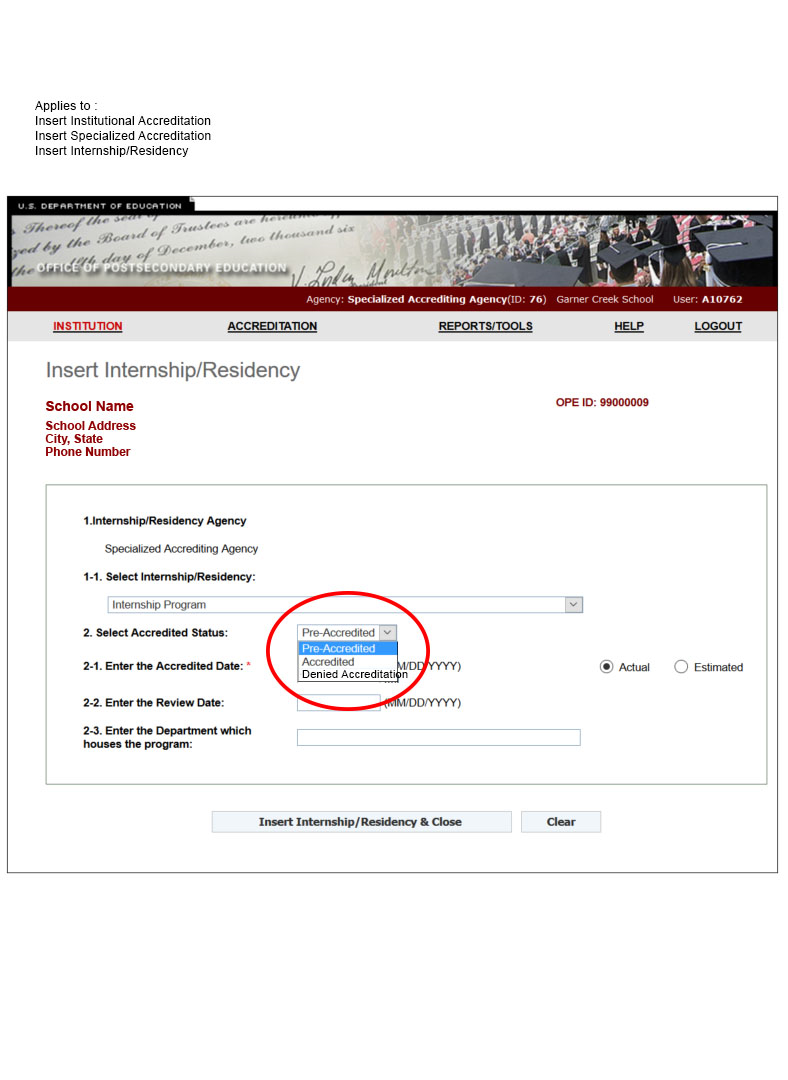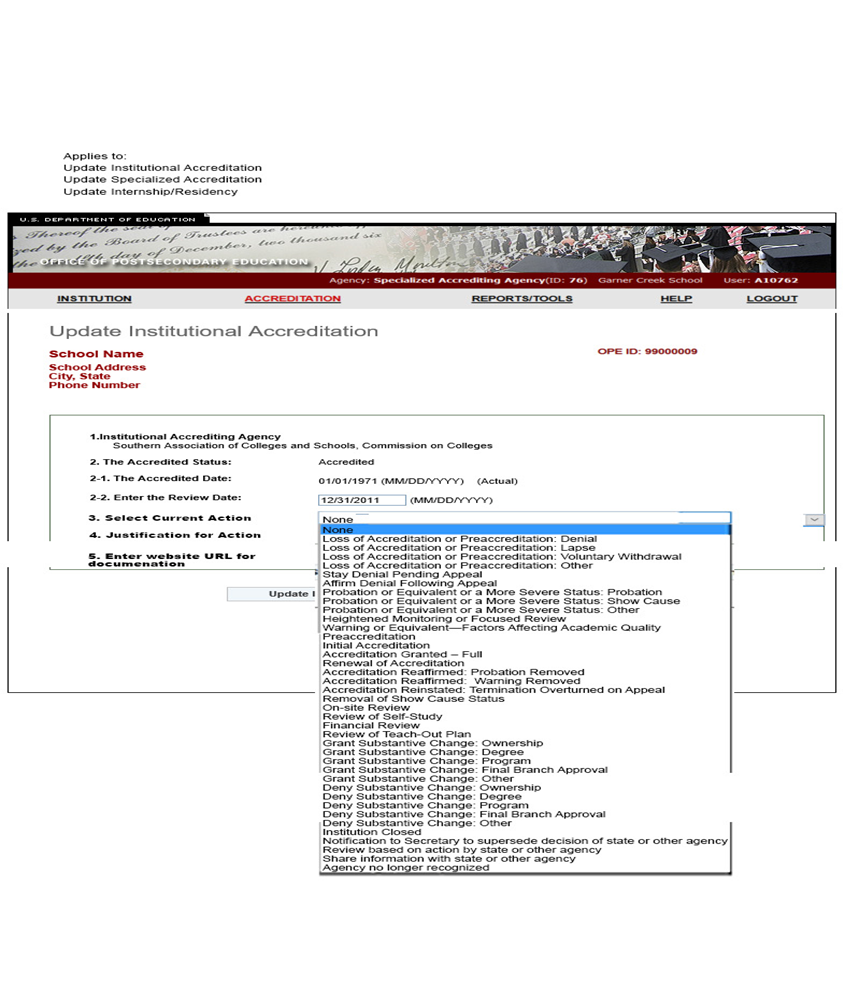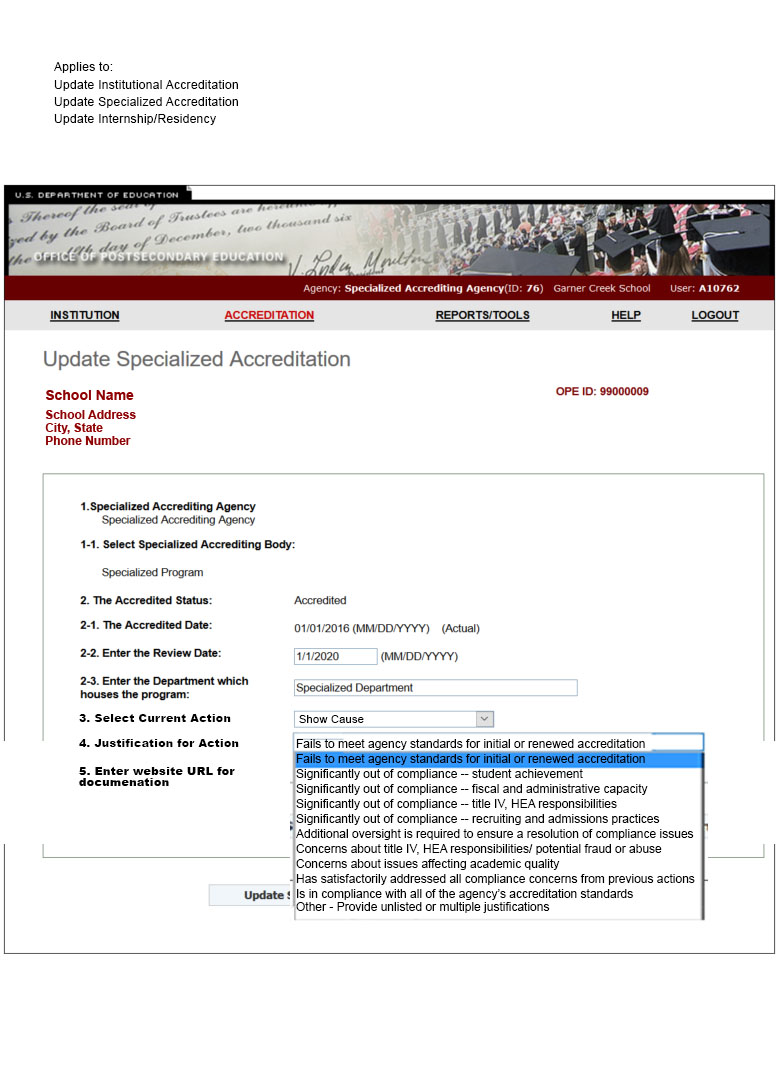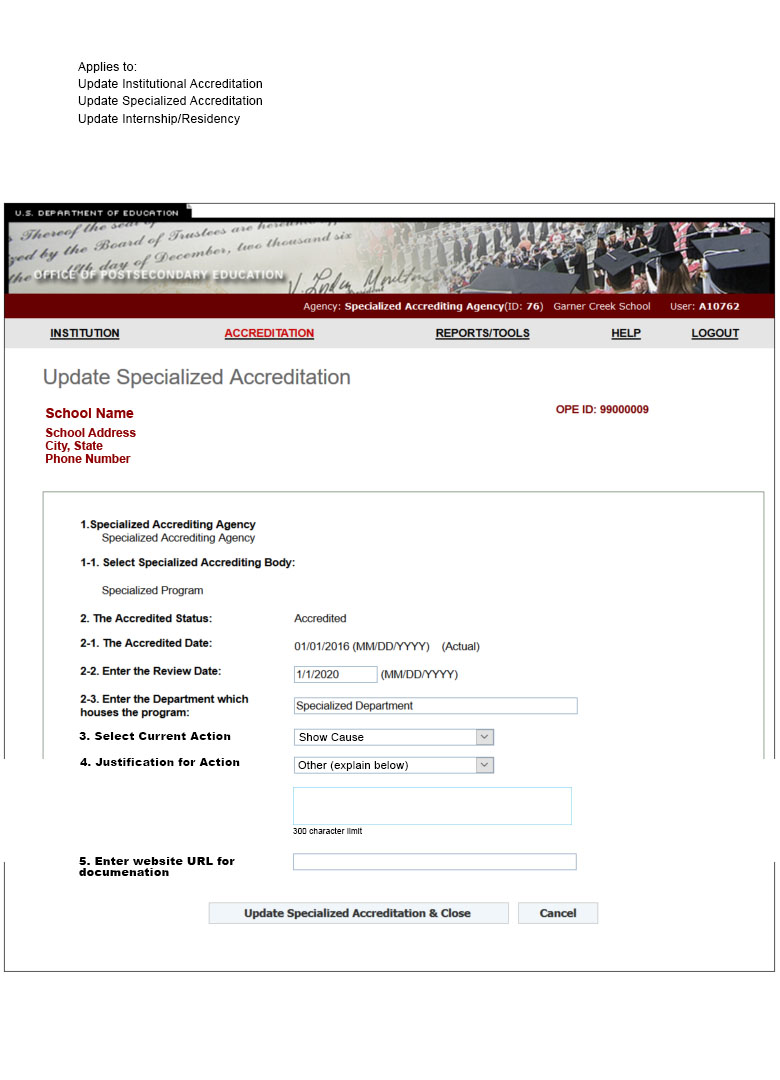The Accreditor Letter on Terminology and Reporting
Accrediting Agencies Reporting Activities for Institutions and Programs
11172016 Accreditation Terminology Guidance-Post 30 Day Comment Revision-Clean
The Accreditor Letter on Terminology and Reporting
OMB: 1840-0838
|
November 17, 2016
Subject: Clarification of Terminology and Requirements for Accrediting Agency Reporting to the U.S. Department of Education
Summary: This letter outlines categories of terminology used by accrediting agencies to describe actions and statuses, and provides guidance to federally recognized accrediting agencies on the information to be reported to the Department under 34 CFR 602.26 and 602.27(a)(6) and (a)(7). Some of the reporting discussed is required; some is requested. This letter specifies which is which. It also discusses the channel for reporting this information, whether requested or required, and for reporting information the accrediting agency may wish to submit voluntarily to ensure that the Department’s Database of Accredited Postsecondary Institutions and Programs (DAPIP) is accurate and comprehensive.1
Dear Federally Recognized Accrediting Agencies:
Students, families, employers, and taxpayers depend on accreditation as a critical marker of educational quality. In November 2015, the Department announced a series of executive actions and legislative proposals “to improve accreditors’ and the Department’s oversight activities and move toward a new focus on student outcomes and transparency.” In a January 20, 2016, memorandum, the Department outlined a number of areas for further action, including the need to clarify terminology used by accreditors and to provide additional guidance to accreditors on information to report to the Department. This letter provides that clarification.
Sections 496(a)(7), (a)(8), (c)(7), and (c)(8) of the Higher Education Act (HEA), and federal regulations at 34 CFR 602.26 and 602.27(a)(6) and (a)(7) contain certain requirements for reporting by recognized accrediting agencies to the Department on the institutions and programs the agencies accredit. This document clarifies the Department’s expectations as to specific information that must be submitted for purposes of compliance with those regulations (e.g., final decision letters regarding probation or withdrawal of accreditation); and specific information the Department is requesting agencies to submit pertinent to academic quality. This memorandum does not change regulatory timelines for submission of information under those regulations, but describes how submissions should be made both in circumstances in which an immediate reporting2 is required, as well as in cases where the applicable regulatory timelines permit submission of a consolidated report that includes more than one category of information. Please note that this guidance regarding reporting by accreditors does not replace or reduce the circumstances in which recognized accrediting agencies must report information to the Department. Nor does it pertain to any reporting requirements existing outside the Department’s recognition regulations (i.e., 34 CFR Part 602), nor to any specific information requests from the Department, nor to information required to be submitted in a recognition proceeding or on a complaint against an agency.
The required reporting outlined in sections 1 and 2 of this letter is mandatory for all federally recognized accrediting agencies, and the required reporting in section 3 of this letter is mandatory with respect to information about institutions and programs participating in the Title IV, HEA, programs. The Department encourages all accrediting agencies recognized for Title IV purposes to follow the reporting requested in section 4 of this letter with respect to institutions and programs participating in the federal student aid programs. This reporting is explained in more detail within each section of the document.
Section 5 and Appendix 1 describe the online collection portal – accessible at https://surveys.ope.ed.gov/accreditation/ – which recognized agencies should use to submit all actions/reporting to the Department described in Sections 1, 2, and 4 of this guidance (in lieu of submission by email or by the previously proposed Excel spreadsheet). The portal should also be used to report other actions or information about an institution that the accrediting agencies would like to accurately and comprehensively reflect in the Department’s Database of Accredited Postsecondary Institutions and Programs (available at http://ope.ed.gov/accreditation/Index.aspx).
Background
The Department of Education, in its work both with institutions of higher education and with accrediting agencies, has noted significant variation in the terminology of accrediting actions taken and statuses applied to various institutions and programs. Differences in the terms used make it difficult for the Department and the public to understand the seriousness of concerns, implications of actions taken, and thus their meaning in terms of the quality of an institution or program and the education it offers. These differences also create challenges as the Department works to protect students and hold institutions, programs and agencies accountable for complying with federal laws and regulations. Under HEA Section 487(a)(15), the Department has a statutory responsibility to obtain from recognized accreditors information pertinent to oversight of institutions participating the HEA, Title IV programs.
In accordance with federal regulations (34 CFR 602.26), all recognized accrediting agencies must report on probation or its equivalent (or more severe action); actions to deny, withdraw, suspend, revoke, or terminate accreditation or preaccreditation; and any other adverse action. However, accrediting agencies frequently use a variety of terms within those categories. Furthermore, even where the terms two accrediting agencies use are different, the definitions are frequently overlapping; or the same term may carry distinct definitions across two agencies. Given the challenges of understanding the actions taken with particular institutions for the purposes of enforcing compliance with federal Title IV, HEA regulations, and in the Department’s work to consider accrediting agencies’ efforts to evaluate academic quality and hold schools and programs accountable when they fail to meet the agencies’ standards, the U.S. Department of Education recommended in November 2015 that Congress require a single federal vocabulary for all major actions and terms, including sanctions and key outcomes.3
In the meantime, the Department has reviewed the terminology used by federally recognized accreditors. The Department is applying information from this review toward two purposes: categorizing terms with similar or related meaning based on their implications for institutions and programs (see terms in boldface in “meaning of terms” sections in this document); and clarifying which actions accreditors are required or requested to report, based on those categories, regardless of the specific label the accreditor may use. This document represents a part of the Department’s efforts to ensure greater transparency around accrediting agencies’ use of actions against institutions and programs and provide the Department with key pieces of information for protecting students and safeguarding taxpayer dollars.
The following sections outline categories of statuses and actions that agencies are expected to report under 34 CFR 602.26 and 602.27(a)(6) and (a)(7) or are requested to report under this guidance; the sets of common terms in that category; and additional information about required and requested reporting to the Department. They also describe the Department’s online reporting portal and when it should be used.
Required Reporting on Loss of Accreditation
Meaning of Terms on Loss of Accreditation
Based on our analysis of agency terminology, “loss of accreditation” means that an institution does not meet the agency standards for accreditation, and the agency is ceasing to accredit the institution. Access to federal Title IV, HEA student financial assistance is terminated accordingly.
In our review, we found that agencies used a multitude of terms to reflect variations on this basic status, including denial, withdrawal, suspension, revocation, or termination of the accreditation or preaccreditation of an institution or program.
Required Reporting to the Department on Loss of Accreditation
Pursuant to 34 CFR 602.26(b), an accrediting agency “[p]rovides written notice . . . to the Secretary, the appropriate State licensing or authorizing agency, and the appropriate accrediting agencies at the same time it notifies the institution or program”of “[a] final decision to deny, withdraw, suspend, revoke, or terminate the accreditation or preaccreditation of an institution or program; [and a] final decision to take any other adverse action, as defined by the agency,” no later than 30 days after it reaches the decision; and provides written notice to the public of those decisions within 24 hours of its notice to the institution or program. Within 60 days, agencies must also provide a brief statement summarizing the reasons for the decision and any official comments the affected institution or program may wish to make or evidence for which the affected institution or program has been offered an opportunity to provide official comment (34 CFR 602.26(d)). For Title IV, HEA institutions accredited by accrediting agencies recognized by the Department for Title IV purposes, the Department regards a copy of the final decision provided to the institution as constituting the summary required.4
Consequently, for schools or programs that receive a final decision about any of these statuses, accrediting agencies must notify the Secretary within 30 days. Within 60 days of making a final decision with respect to a Title IV institution, agencies recognized for Title IV purposes must submit to the Secretary the final decision letter, and for other agencies the final decision letter or other summary, describing the basis for the action against the institution or program as provided in 34 CFR 602.25(e), or 602.25(g), as applicable, together with any official comments from the institution or program (or evidence that the institution has been provided with an opportunity to submit such comments). The requirement applies in the event of withdrawal of accreditation by a Title IV (institutional) accreditor with respect to a specific program or programs housed within an institution it accredits. Accreditors must use the online collection portal to share decision letters with the Department’s Accreditation Group. Unless notified otherwise, accreditors are required to make these documents available to the Department by using the online collection portal to submit the web address (i.e., URL) to the decision letter, with appropriate redactions (described below in Section 5).
Pursuant to 34 CFR § 602.26(d), recognized agencies must notify the Secretary, the appropriate State licensing or authorizing agency, the appropriate accrediting agencies, and, upon request, the public if an accredited or preaccredited institution or program decides to withdraw voluntarily from accreditation or preaccreditation, or lets its accreditation or preaccreditation lapse. These notices are due within 30 days of the agency’s receipt of the notice of withdrawal or of the date the accreditation or preaccreditation lapses, as applicable. Accreditors must use the online collection portal to timely notify the Secretary of these events.
Required Reporting on Probation or Equivalent or More Severe Agency Actions
Meaning of Terms on Probation or Equivalent or More Severe Agency Actions
Based on our analysis of agency terminology, probation is typically defined as significant noncompliance with accrediting agency standards, but not loss of accreditation. Accordingly, and in light of the existing regulatory scheme, the Department regards the following as actions constituting “probation or an equivalent status”:
An action or assessment that indicates an institution or program is significantly out of compliance with one or more of the accrediting agency’s standards, but it is possible that the noncompliance could be remedied by the institution or program within a period allowed by the agency and the regulations.5
The above definition includes any sanction indicating significant non-compliance, regardless of the term used by an agency to describe such sanction. For example when an agency uses the term warning to indicate significant non-compliance, such a warning should be categorized as probation and reported as such. For at least some accrediting agencies, this category would include show cause orders: serious compliance issues that must be addressed by an institution in order to retain its accreditation. Any status that is not a loss of accreditation but is more severe than probation (as described in this letter), in terms of the risk of loss of accreditation, also falls within this category.
Required Reporting to the Department on Probation or Equivalent or More Severe Agency Actions
Pursuant to 34 CFR 602.26(b), an accrediting agency “[p]rovides written notice to the Secretary, the appropriate State licensing or authorizing agency, and the appropriate accrediting agencies at the same time in notifies the institution or program” of “[a] final decision to place an institution or program on probation or an equivalent status,” no later than 30 days after it reaches the decision; and provides written notice to the public of those decisions within 24 hours of its notice to the institution or program. Accrediting agencies whose definition of probation does not include all actions described above must include those additional actions in their reporting to satisfy the regulatory reporting requirements concerning probation. Pursuant to HEA Section 487(a)(15), the Department has determined that for purposes of effective oversight of institutions participating in the federal student aid programs, it also needs an explanation of the reasons why a Title IV institution was placed on probation or an equivalent or more severe status.
Based on our analysis of the timeline of agency actions, the decision to place an institution or program on probation or an equivalent or a more severe status as a result of noncompliance with the agency's standards is not typically made at the time the agency staff or site visitation team observes the issues of concern, but rather when the agency’s decision-making body meets, with the reason for that decision then expressed in the agency’s decision letter under 602.25(e) or 602.25(g), as applicable. At the meeting of the agency’s decision-making body, if it determines that at least one of the issues of concern results in significant noncompliance with the agency standards, such assessment constitutes probation or its equivalent or a more severe status, as defined by this letter, and must be reported to the Department. Conversely, if the decision-making body determines that none of the issues of concern indicates that the institution or program is significantly out of compliance with the agency standards and the institution or program is not placed on probation, then the requirement for reporting on probation is not applicable.
Accordingly, for schools or programs placed on probation or its equivalent or a more severe status, as described above, accrediting agencies must notify the Secretary, and agencies recognized for Title IV purposes must submit to the Secretary the final decision letter for Title IV institutions, describing the basis for the action as provided in 34 CFR 602.25(e), within the required time period. Accreditors must use the online collection system (https://surveys.ope.ed.gov/accreditation/) to notify the Department of the action, the justification for the action, and the web address (URL) of the decision letter. Similarly, agencies should also use the online collection system to notify the Department of its decision to take an institution off of probation or an equivalent or more severe sanction.
Required Reporting on Title IV Issues
Meaning of Terms on Title IV Issues
Each federally recognized accrediting agency is required by 34 CFR 602.27(a)(6) to report “[t]he name of any institution or program it accredits that the agency has reason to believe is failing to meet its Title IV, HEA program responsibilities or is engaged in fraud or abuse, along with the agency’s reasons for concern about the institution or program.”
34 CFR 602.27(a)(7) requires each federally recognized accrediting agency to report, “[i]f the Secretary requests, information that may bear upon an accredited or preaccredited institution’s compliance with its Title IV, HEA program responsibilities, including the eligibility of the institution or program to participate in Title IV, HEA programs.”
Required Reporting to the Department on Title IV Issues
The Department expects prompt compliance with these reporting requirements.
Through this guidance, the Secretary is also instituting a standing request for purposes of 34 CFR 602.27(a)(7) -- that whenever an agency makes a report under 34 CFR 602.27(a)(6), the agency should also submit all information that prompted the agency’s concern. Information must be shared with the Department of Education’s Accreditation Group in accordance with the current procedures, including the requirement that such information be reported immediately. Agencies should submit notifications under 34 CFR 602.27(a)(6) and (a)(7) directly to the Department using both of the following email addresses: [email protected] and [email protected].
Requested Reporting on Other Factors That Affect Academic Quality at Title IV Institutions
Meaning of Terms on Factors that Affect Academic Quality
The Department has a strong interest in understanding the nature of certain other accreditor actions, where they indicate potential issues with the academic quality of the institution, for the purpose of monitoring accredited institutions participating in the Title IV, HEA programs. In particular, the Department is interested in accreditors’ concerns about Title IV institutions that, while not on probation or an equivalent or a more severe status as described above, are in noncompliance with or at risk of failing to comply with the following accreditation standards, as outlined in 34 CFR 602.16(a)(1):
Success with respect to student achievement in relation to the institution’s mission, which may include different standards for different institutions or programs, as established by the institution, including, as appropriate, consideration of state licensing examinations, course completion, and job placement rates.
…
(v) Fiscal and administrative capacity as appropriate to the specified scale of operations.
Student support services.
…
(vii) Recruiting and admissions practices, academic calendars, catalogs, publications, grading, and advertising.
…
(viii) Measures of program length and the objectives of the degrees or credentials offered.
(ix)
Record of student complaints received by, or available to, the
agency.
Such issues may arise in the form of an action, not listed above, that is taken by the accrediting agency. Those actions may include warnings, notations, and admonitions or conditions, contingencies, or stipulations, among others.
Requested Reporting to the Department on Factors that Affect Academic Quality
The Department requests information about cases in which accreditors have relayed concerns to Title IV institutions that, while not on probation or an equivalent or a more severe status, are in noncompliance with or at risk of failing to comply with accreditation standards as described in Section 4.A. of this guidance. Except where 34 CFR § 602.27(a)(6) or (a)(7) apply, such reporting is voluntary and failure by agencies to provide it warrants no negative action by the Department. However, the Department strongly encourages all federally recognized accrediting agencies to report this information as it may contribute to the ongoing monitoring of the Title IV, HEA federal financial aid programs. For 34 CFR 602.16(a)(1)(i), the Department is particularly interested in issues related to retention and completion of course, program, and certificate or degree; job placement; licensure exam participation and passage; student debt repayment and default; and student satisfaction.
When reporting information requested under 34 CFR 602.16(a)(1), agencies should utilize the online reporting portal described in section 5 and Appendix 1 of this guidance to notify the Department of the action being taken, the justification for the action, and the web address (URL) of the associated document. Agencies should use this system to report both the factors affecting academic quality and the resolution of these concerns.
Submission of Information to the Department Through the Integrated Online Reporting Portal
In order to improve accreditors’ reporting and enable the Department to monitor institutions and their accrediting agencies more effectively, and to better protect students, families, and taxpayers, the Department requires accrediting agencies submitting information and decision letters required under 34 CFR § 602.26 and Sections 1 and 2 of this guidance to do so via the online collection portal at https://surveys.ope.ed.gov/accreditation/. Accrediting agencies electing to submit information and decision letters requested under 34 CFR § 602.16 and Section 4 of this guidance must also use this portal for those submissions. The portal will replace the existing multiple reporting channels (such as email and the previously proposed Excel spreadsheet) used in complying with 34 CFR 602.26. The Department will contact each accrediting agency to provide them a unique log-in to access the portal. In addition to submitting the required and requested information outlined in this guidance letter, accreditors should also use the portal to report any other actions that they deem appropriate in the interests of the comprehensiveness and accuracy of the information about their accredited institutions appearing on the Department’s accreditation database.
However, reporting under 34 CFR 602.27(a)(1) – 602.27(a)(7), 602.19(e) and 602.28(c), should be submitted directly to the Department through both of the following email addresses: [email protected] and [email protected]. They should not be submitted through the portal. The Department would like to highlight that in accordance with the current procedures and regulatory requirements, such information must be reported immediately. Likewise, agencies reporting other agency actions that are neither required to be made public, nor appropriate for public posting, should be submitted directly to the Department via these two email addresses rather than submitted through the portal.
The Department would also like to clarify that the portal is not designed for the filing of information and documents as part of recognition proceedings (for example, agency submissions under 34 CFR 602.30 and 602.31 should be submitted to the Department’s Accreditation Group at https://opeweb.ed.gov/aslweb/ as in the past, or directly to the Accreditation Group analyst if so requested (for purposes of complaints against the agency, etc.).
The portal contains fields for updating an institution’s accreditation status and information, as well as a menu of agency actions and justification for those actions from which accreditors can make selections by selecting the appropriate options (see Appendix 1 of this guidance). It also provides a field for agencies to enter the web address (URL) of the relevant supporting document (e.g., decision letter).
Agencies should note that unless notified otherwise, submission of decision letters to the Department’s Accreditation Group should be done by entering the web address (URL) to the letter in the online portal (see Appendix 1).
The Department would like to emphasize that agency confidentiality rules do not govern obligations to report to the Department. Before posting URLs for decision letters as described above, an agency may redact information that would identify individuals, or any other confidential commercial or financial business information it believes in good faith would qualify as non-public under 34 CFR 5.11. If the Department nonetheless concludes it needs this information for oversight purposes, or that redactions made in reliance on 34 CFR 5.11 are not made in good faith, it will require the agency to provide a non-redacted copy, and specify how that submission is to be made.
The Department continues to explore opportunities to improve information submission processes to enhance all parties’ ability to utilize the information quickly and effectively. We will continue to partner with accrediting agencies to better streamline and improve reporting procedures.
Accrediting agencies and the Department share an interest in ensuring a high-quality education for all students at accredited institutions. The steps outlined in this memo will increased our collective ability to ensure that quality. The Department appreciates the partnership of accrediting agencies in this effort.
Sincerely,
Ted Mitchell
Under Secretary
U.S. Department of Education
Appendix 1: Mock-up of Online Reporting Portal
To update an institution’s accreditation status, click on the drop-down menu for Select Accredited Status, then select the appropriate status.

To report an action or sanction, click on the corresponding item in the drop-down menu. The menu contains multiple options, including adverse actions such as Deny Accreditation, and Loss of Accreditation, non-adverse actions such as Accreditation Granted, Renewal of Accreditation, and Initial Accreditation. The drop-down also contains other actions – such as Grant or Deny Substantive Change – that an accreditor may deem appropriate to report in the interests of the comprehensiveness and accuracy of the information about their accredited institutions appearing on the Department’s accreditation database.






To submit the reason for the agency’s action, use the drop-down menu for Justification for Action to select the reason for the action. If the justification is not among the options listed or if there are multiple reasons for a single action, then click Other—Provide unlisted or multiple justifications.






After clicking Other—Provide unlisted or multiple justifications, a text box will appear. Use this text box to report multiple or unlisted justifications.







Use the field titled Enter website URL for documentation to provide the location of the decision letter.





Appendix 2: Glossary of Terms for Accreditation Agency Actions
Term |
Definition |
Deny accreditation |
Agency refuses to accredit an institution seeking initial accreditation |
Loss of accreditation or of pre-accreditation |
Agency terminates or refused to renew an institution's accreditation. |
Probation or equivalent or a more severe status |
An action or assessment that indicates an institution or program is significantly out of compliance with one or more of the accrediting agency’s standards, but it is possible that the noncompliance could be remedied by the institution or program within a period allowed by the agency and the regulations. (Please refer to Section 2 of the guidance letter for further clarification). |
Show Cause |
Any serious compliance issue that must be addressed by an institution in order to retain its accreditation. If as defined or applied by the agency the status is equivalent to or more severe than probation as described above, Show Cause should be reported as “Probation or equivalent or more severe status: Show Cause” |
Heightened Monitoring or Focused Review |
Agency subjects an institution to additional oversight for a variety of compliance issues. If as defined or applied by the agency the status is equivalent to or more severe than probation as described above, Heightened Monitoring should be reported as “Probation or equivalent or more severe status: Other” |
Preaccreditation |
Agency grants preliminary accreditation to institution; institution needs to meet certain additional requirements to earn fully accredited status. |
Initial accreditation |
Agency grants accreditation to an institution for the first time |
Accreditation granted -- full |
Agency grants full accreditation to institution; institution has met all requirements for fully accredited status. |
Renewal of accreditation |
Agency reaffirms institution's accreditation after periodic review of compliance with accrediting standards. |
Accreditation reaffirmed -- probation removed |
Agency reaffirms institution's accreditation after the institution successfully addressed all requirements for removing probation status. |
Accreditation reaffirmed -- warning removed |
Agency reaffirms institution's accreditation after institution successfully addressed all requirements for removing warning status. |
Accreditation reinstated -- termination overturned |
Agency reaffirms institution’s accreditation after institution successfully appealed termination decision. |
Removal of show cause |
Agency determines that an institution has satisfactorily addressed serious compliance issues for it to retain its accreditation status. |
Warning or equivalent -- Factors Affecting Academic Quality |
Agency’s concern about an institution’s potential noncompliance that could result in probation if not addressed. Such actions may include warnings, notations, or admonitions regarding issues that may affect academic quality. If the Warning status as defined or applied by the agency is less severe than probation as defined above, agencies are not required but highly encouraged to report such actions. If the Warning status as defined or applied by the agency is equivalent to or more severe than probation, Warning should be reported as “Probation or equivalent or more severe status: Other” |
Appendix 3: Public Burden Statement
According to the Paperwork Reduction Act of 1995, no persons are required to respond to a collection of information unless such collection displays a valid OMB control number. The valid OMB control number for this information collection is 1840-NEW. Public reporting burden for this collection of information is estimated to average 20 minutes per response, including time for reading instructions, completing online forms, and creating and posting URL to decision letters. The obligation to respond to this collection is required to obtain or retain benefits (34 CFR 602.26). If you have comments or concerns regarding the status of your individual submission of this form, application, or survey, please email Herman Bounds, Director of Accreditation Group (OPE) at [email protected]. [Note: Please do not return the completed instrument, form, application or survey to this address.]
1 The Department’s database of accredited institutions and programs is available at http://ope.ed.gov/accreditation/Index.aspx .
2 In particular, compliance with 34 CFR 602.27(a)(6) and (a)(7) requires prompt submissions. It is not acceptable for an agency to delay such submissions in order to consolidate them with reporting required under other provisions of those regulations.
3 “Department of Education Advances Transparency Agenda for Accreditation.” U.S. Department of Education. Fact Sheet: November 2015. Available at www.ed.gov/accreditation.
4 For purposes of this guidance, a Title IV accreditor is responsible for reporting on all of the Title IV institutions it accredits, regardless of whether one or more of those institutions, if dually accredited, may have designated another agency as its Title IV accreditor for purposes of 34 CFR § 600.11(b)(3).
5 The Department notes that when an institution or program is out of compliance with any of the agency’s accrediting standards, the timelines under 34 CFR 602.20 begin to run, with adverse action required in the event compliance is not achieved within those timeframes (as extended, if applicable, based on good cause shown in accordance with the agency’s published policies), regardless of whether the agency initially regarded the institution’s or program’s noncompliance as not significant enough to require the public sanction of probation.
Based on the practices common to recognized agencies and on the statutory and regulatory requirements that recognized accreditors perform effectively, at a minimum, noncompliance is viewed as significant if, notwithstanding the agency’s best judgment that the institution or program will achieve compliance within the permissible timeframe, the area of non-compliance implicates institutional integrity; or, for example, the number of areas of noncompliance, institutional finances, or other circumstances cast reasonable doubt on whether compliance can be achieved in the time permitted; or the institution or its affiliates demonstrate recurrent noncompliance with one particular standard or standards; or the area of noncompliance is one for which notice to the public is required in order to serve the best interests of students and prospective students.
| File Type | application/vnd.openxmlformats-officedocument.wordprocessingml.document |
| Author | McCann, Clare |
| File Modified | 0000-00-00 |
| File Created | 2021-01-24 |
© 2025 OMB.report | Privacy Policy